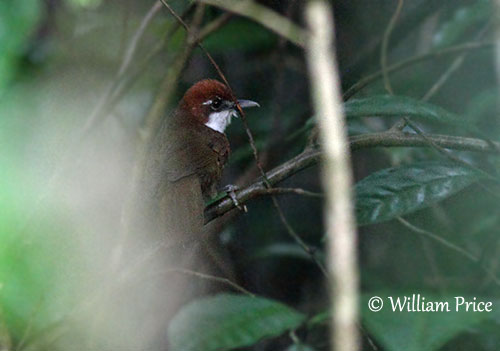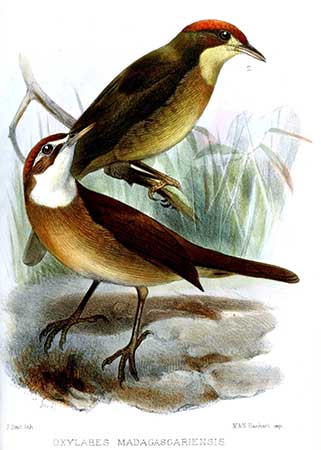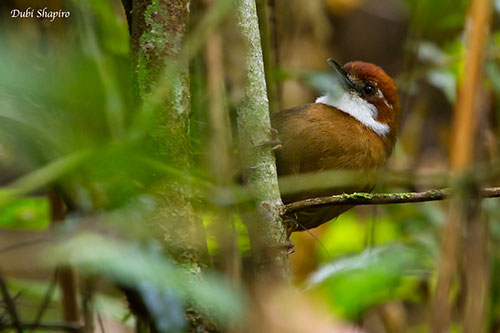
Fr: Oxylabe à gorge blanche
Ang: White-throated Oxylabes
All: Weißkehlfoditany
Esp: Silvícola Sirontsirona
Ita: Oxilabe golabianca
Nd: Witkeeloxylabes
Sd: vitstrupig madagaskarsångare
Mal: Farifitra mena, Sirontsirona, vangamaintiloha
Photographer:
William Price
PBase-tereksandpiper & Flickr William Price
Dubi Shapiro
Dubi Shapiro Photo Galleries & Dubi Shapiro's Pictures on IBC
Illustration:
Joseph Smit (1836-1929)
Illustration’s Origin:
Proceedings of the Zoological Society of London (vol. 1872, plate LXXIII)
Text by Nicole Bouglouan
Sources :
HANDBOOK OF THE BIRDS OF THE WORLD Vol 11 by Josep del Hoyo, Andrew Elliott and David Christie - Lynx Edicions - ISBN: 849655306X
Birds of Madagascar: A Photographic Guide Par Pete Morris, Frank Hawkins – ISBN: 0300077556, 9780300077551- Editeur: Yale University Press, 1998
Wildlife of Madagascar par Ken Behrens,Keith Barnes - ISBN: 140088067X, 9781400880676 – Editeur: Princeton University Press, 2016
Birds of Madagascar and the Indian Ocean Islands Par Roger Safford, Adrian Skerrett, Frank Hawkins – ISBN: 1472924118, 9781472924117- Editeur: Bloomsbury Publishing, 2015
The Birds of Africa: Volume VIII: The Malagasy Region: Madagascar, Seychelles, Comoros, Mascarenes - Par Roger Safford, Frank Hawkins – ISBN: 1408190494, 9781408190494- Editeur: A&C Black, 2013
CREAGUS - MALAGASY WARBLERS Bernieridae
Fatbirder - Bernieridae - Malagasy Warblers
Wikipedia, the free encyclopaedia
White-throated Oxylabes
Oxylabes madagascariensis
Passeriformes Order – Bernieridae Family
INTRODUCTION:
The White-throated Oxylabes is endemic to Madagascar. It is found in the eastern rainforest and occurs in the dense understorey.
It was formerly part of the Old World warbler family Sylviidae, but it is now a member of the family Bernieridae, the Malagasy warblers, endemic to Madagascar. It is the sole member of the genus Oxylabes.
The White-throated Oxylabes is vulnerable to habitat destruction through deforestation, but the species is not currently globally threatened.
DESCRIPTION OF THE BIRD:
Biometrics:
Length: 17-18 cm
Weight: 18-30 g
The White-throated Oxylabes has dull dark brown back, wings and tail. The wings are short whereas the tail is fairly long.
On the underparts, chin and throat are white. Breast and belly are dull dark brown, slightly brighter on the upper breast.
On the head, crown, cheeks and nape are rufous-brown. There is a narrow, white supercilium, more conspicuous behind the eye. It is often longer in males. We can see a small, white spot in front of the eye.
The strong, fairly long bill is dull dark grey. The eyes are dark reddish-brown. Strong legs and feet are dark grey or dull brown.
Male and female are similar.

The juvenile has dark blackish-grey head and dark olive-brown rest of plumage, with some yellow spots on neck side, and greenish-yellow fringes to wing feathers. The gape is yellow.
The throat becomes soon pale buffy to buffy-yellow, sometimes extending to the lower breast. Crown and nape become dull rufous. The green-yellow fringes disappear from the wings too.
RANGE:
The White-throated Oxylabes is found in N, NW and E Madagascar (Montagne d’Ambre, and Tsaratanana and Sambirano, S to Andohahela).
HABITAT:
The White-throated Oxylabes frequents the understorey of the evergreen humid forest, from sea-level to 1,600 metres of elevation, but it is more common at mid-altitudes, between 800 and 1,600 metres. It may occasionally forage at forest-edge, close to the primary forest.
CALLS AND SONGS: SOUNDS BY XENO-CANTO
The White-throated Oxylabes gives a high-pitched, descending trill “ssshhrewwww” used as contact call. We can also hear a quiet ‘tsit” when close.
The song is a duet, with one bird singing a short, whistled “whit-treet tirooet teeoo” and the other bird giving a loud, wooden rattled call in half way. But both elements can also be heard separately.
BEHAVIOUR IN THE WILD:
The White-throated Oxylabes feeds mainly on insects such as Scarabeidae, homopteran bugs and orthopterans. It also catches spiders.
It usually feeds on the ground, but it also climbs up to 5 metres above the ground to probe in dead leaf stumps. It may sometimes follow rodents.

Juvenile (top) and adult male
It is often seen in pairs or family groups, but they join mixed-species flocks with Madagascan Yellowbrow, Dark Newtonia, Appert’s Tetraka and some other tetrakas. They move together on the ground through the dense understorey.
The White-throated Oxylabes can be seen hopping on the ground, but it climbs easily on low branches when singing.
The courtship behaviour is unknown, but we can suggest that the contrasted head/throat pattern is enhanced by adapted postures during the displays.
The White-throated Oxylabes is sedentary.
The short wings and the fairly long tail indicate mostly terrestrial habits. The bird flies rarely and only over short distances.
REPRODUCTION OF THIS SPECIES:
The breeding season occurs between August and December, often earlier than other rainforest bird species.
The White-throated Oxylabes builds a cup-shaped nest in the crown of tree fern, about 1-2 metres above the ground.
The female lays two eggs. No more information.
PROTECTION / THREATS / STATUS:
The White-throated Oxylabes is common in humid forest in E and N Madagascar. It is present in several protected areas within its range.
The population is suspected to be declining due to habitat destruction by clearance and deforestation.
However, the White-throated Oxylabes is not globally threatened and currently evaluated as Least Concern.
